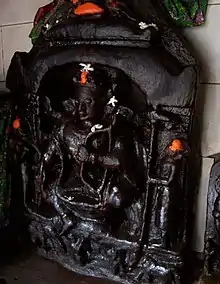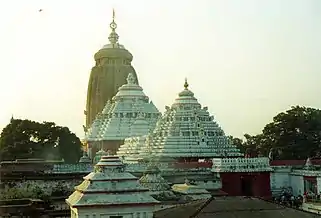Anantavarman Chodaganga
Anantavarman Chodaganga (r. 1077–1150) was a ruler of the Eastern Ganga dynasty which ruled the southern part of Kalinga, India. He was the son of Rajaraja Deva and Rajasundari, the daughter of emperor Virarajendra Chola. The Chola king Kulothunga Chola I of the Chola dynasty was his uncle. However, historian S.N. Sen states that Anantavarman was the maternal grandson of Kulottunga I. The Jagannath Temple at Puri was rebuilt in the 11th century[1] atop its ruins by Anantavarman Chodaganga.[2]
| Anantavarman Chodaganga | |
|---|---|
 | |
| Ruler of Eastern Ganga dynasty | |
| Reign | c. 1077 – c. 1150 CE |
| Father | Rajaraja Deva |
| Mother | Rajasundari |

King Chodaganga was originally a Shaivite from Srimukhalingam(which was in Kalinga/Odisha till 1934,as part of Undivided Ganjam District) but embraced Sri Vaishnavism under the influence of Sri Ramanuja when the latter visited the Jagannath Puri temple.[3][4][5] In his Sindurapura grant(1118 A.D) Anantavarma styles himself Paramavaishnava.[6] Despite being related to Anantavarman, Kulothunga Chola I did not stop from burning Anantavarman's empire. Historians propose that it was probably because the king failed to pay his rent for two consecutive years. He was ousted by Kulothunga's general Karunakara Thondaiman and this victory is detailed in the Tamil classic Kalingattupparani. Monarchs from this region of the subcontinent regularly assumed the title Chodaganga Deva throughout the ancient and medieval periods to allude to their Chola and Ganga heritage
From various inscriptions it is known that King Anantavarman Chodaganga Deva established the present temple some time near the end of the eleventh century. A copper plate inscription made by King Rajaraja III found on the Tirumala Venkateswara Temple near the north entrance states that Jagannath temple was built by Gangesvara, i.e., Anantavarman Chodaganga Deva.
Later, King Ananga Bhima Deva II (1170–1198) did much to continue the work of Chodaganga Deva, building the walls around the temple and many of the other shrines on the temple grounds. He is thus often considered one of the builders of the temple. He also did much to establish the regulations around the service to the Deity.
A scion of this dynasty made rich donations to the Koneswaram temple, Trincomalee on Puthandu, 1223 CE in the name of King Chodaganga Deva. Shortly afterwards, the Konark temple was constructed in Odisha. A brother of the king titled Ulagaikonda Permadi is known to us from several inscriptions.[7]
Sources
- Sastri, K. A. Nilakanta (2000) [1935]. The Cōlas. Madras: University of Madras. pp. 322–323.
References
- Sen, Sailendra (2013). A Textbook of Medieval Indian History. Primus Books. pp. 36–37. ISBN 978-9-38060-734-4.
- Cesarone, Bernard (2012). "Bernard Cesarone: Pata-chitras of Orissa". asianart.com. Retrieved 2 July 2012.
This temple was built between approximately 1135-1150 by Codaganga
- Orissa (India). Public Relations Dept, Orissa (India). Home Dept. Orissa Review, Volume 44. Home Department, Government of Orissa, 1987. p. 56.
- Dinanath Pathy. Traditional Paintings of Orissa. Working Artists Association of Orissa, 1990 - Painting, Indic - 93 pages. p. 16.
- Oḍiśa Saṃskr̥ti Parishada. Studies in the cult of Jagannātha. Institute of Orissan Culture, 1991 - Religion - 256 pages. p. 150.
- Joanna Gottfried Williams. Kalādarśana: American Studies in the Art of India. BRILL, 1981 - Art, Indic - 183 pages. p. 39.
- Archaeological Survey of India, India. Dept. of Archaeology. Epigraphia Indica, Volume 30. Manager of Publications, 1987. p. 92.